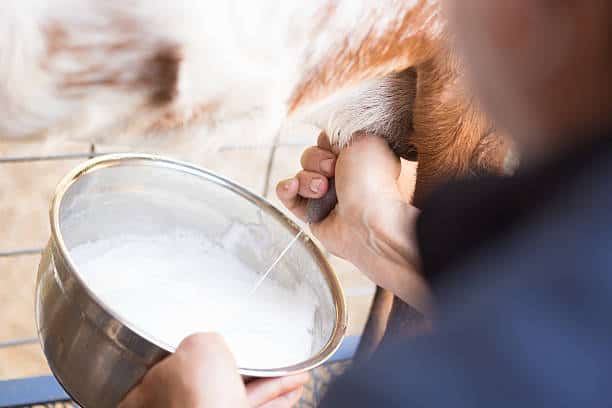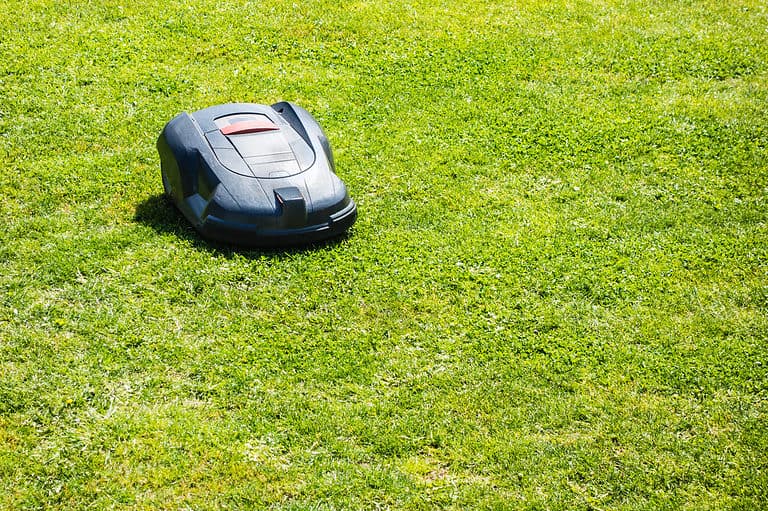Best Practices for How to Improve Pasture Drainage
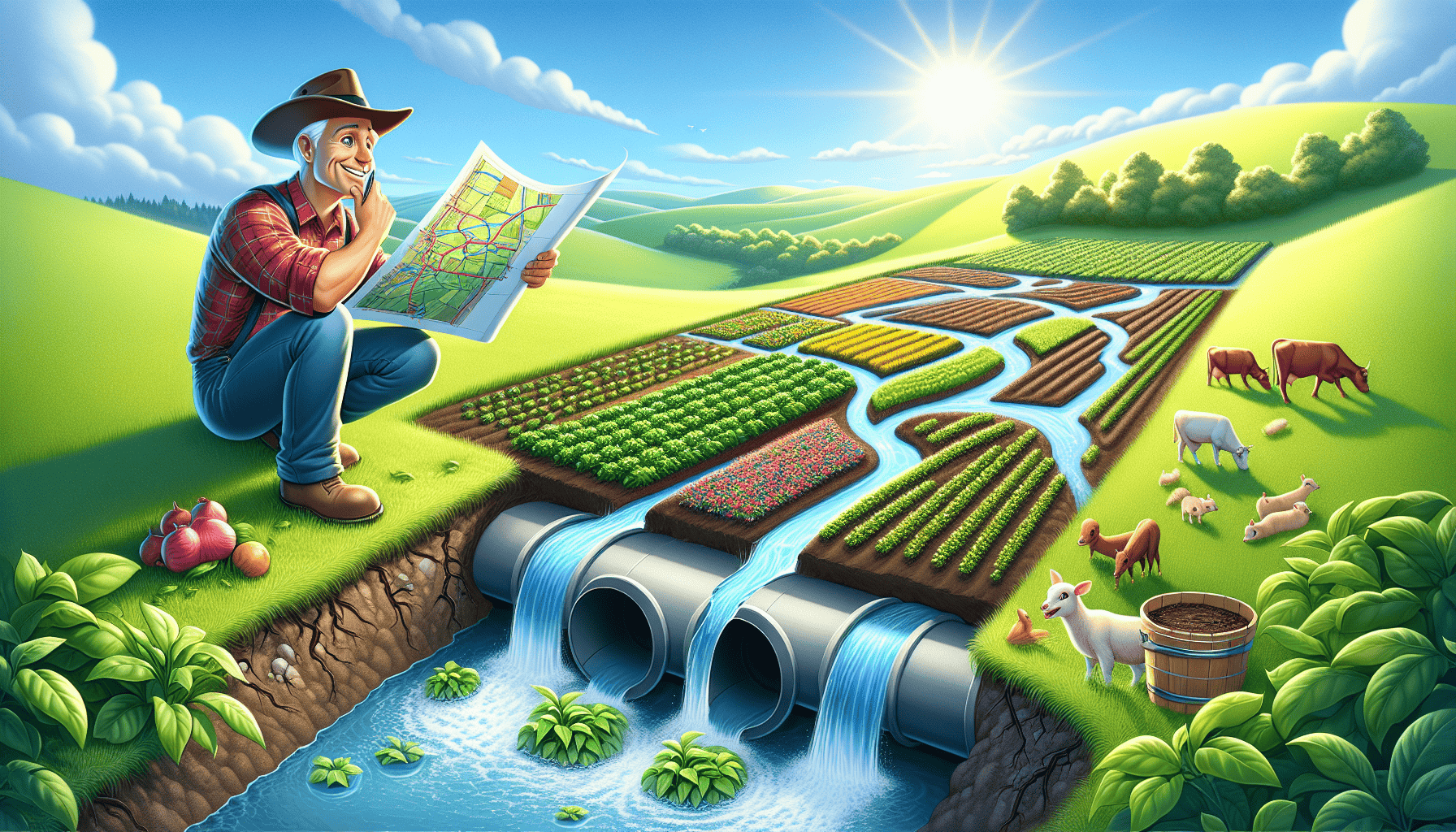
Struggling with soggy pastures? Inadequate drainage can wreak havoc on both your crops and the soil. Consult this guide for enhancing pasture drainage to discover problems and apply effective measures that will maintain a robust and fruitful pasture.
Key Takeaways
Identifying pasture drainage issues, such as waterlogging and soil saturation, is essential to improving crop potential and soil health.
Effective drainage system design requires analysis of soil type, topography, and tailored solutions like surface and subsurface drainage techniques.
Regular maintenance and inspections of drainage systems are crucial for longevity and effectiveness, with seasonal checks aligning with weather patterns.
Assessing Pasture Drainage Issues
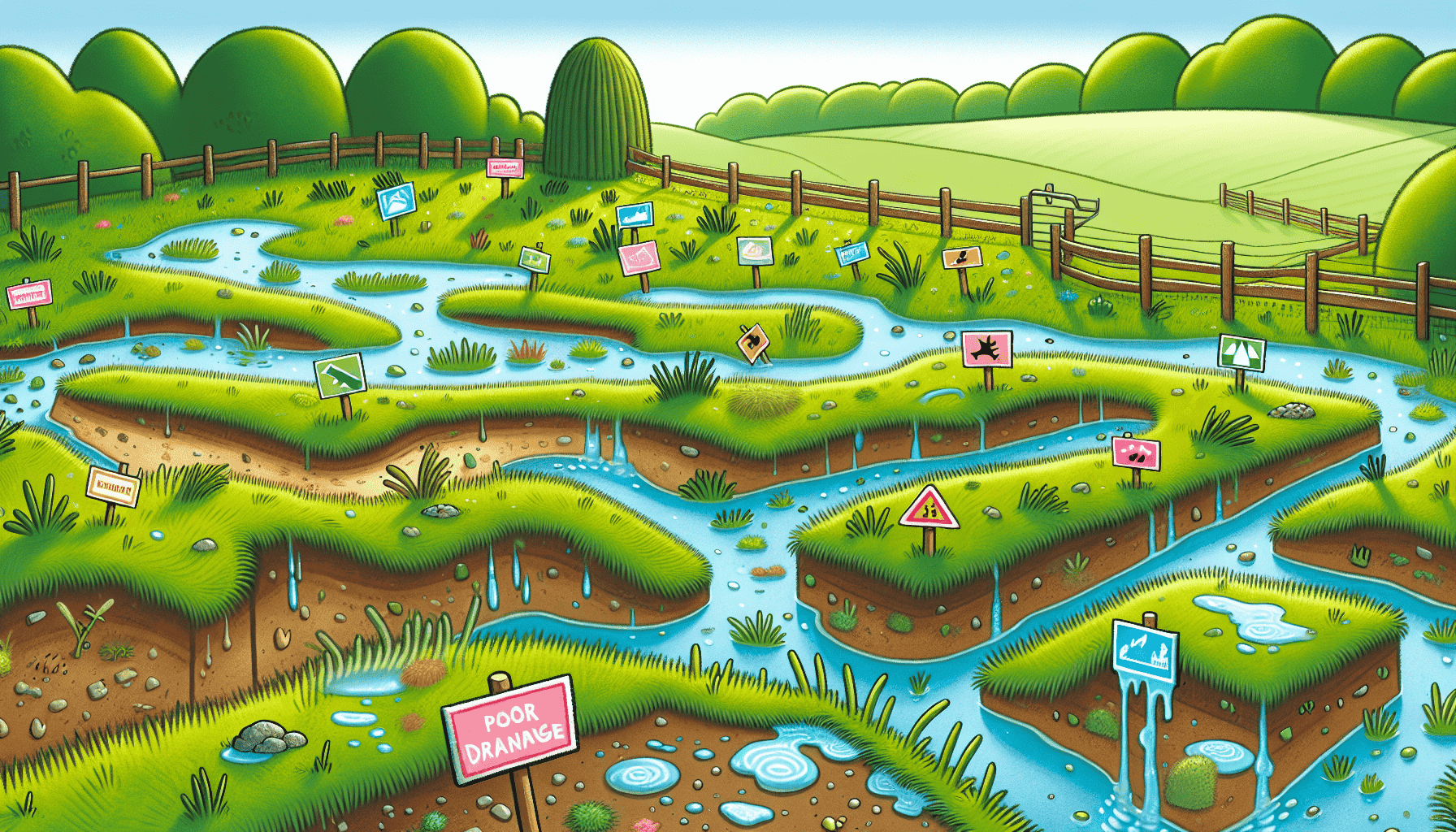
Grasping the specifics of the drainage challenges faced by your pasture is paramount in pursuing successful remedies. Suboptimal drainage can drastically diminish both the productivity potential of crops and the vitality of soil, underscoring the importance of early recognition and intervention regarding such issues.
By understanding the distinctive qualities inherent to your soil, you are better equipped to customize strategies that cater specifically to addressing those needs unique to your terrain.
Common Signs of Poor Drainage
Signs of inadequate drainage in pastures, such as evident waterlogging and persistently damp conditions, negatively affect pasture expansion and reduce crop yield by causing the soil pores to retain minimal or no air. This situation adversely influences root development and compromises the vitality of plants.
When the water table is near the surface level of the soil, it points towards insufficient drainage. Such saturated environments put crops under strain and obstruct proper root oxygenation, highlighting that efficient drainage systems are essential for maintaining plant health.
Soil Type and Topography Analysis
The drainage capabilities of soil are heavily dependent on its texture and composition. For instance, soils with a coarser structure tend to have superior drainage abilities than those that are finer. Likewise, the performance of tile drainage systems is contingent upon the type of soil which dictates how far apart and deep the tiles should be positioned.
Equally important in determining efficient water flow within a drainage system is land topography. Areas with flat terrain often experience less effective drainage as there’s limited incline to facilitate water movement and reduce pooling. Understanding both your land’s topography and its soil profile can greatly assist in devising an optimal tile-based drain system suited specifically for your agricultural needs.
Designing an Effective Drainage System
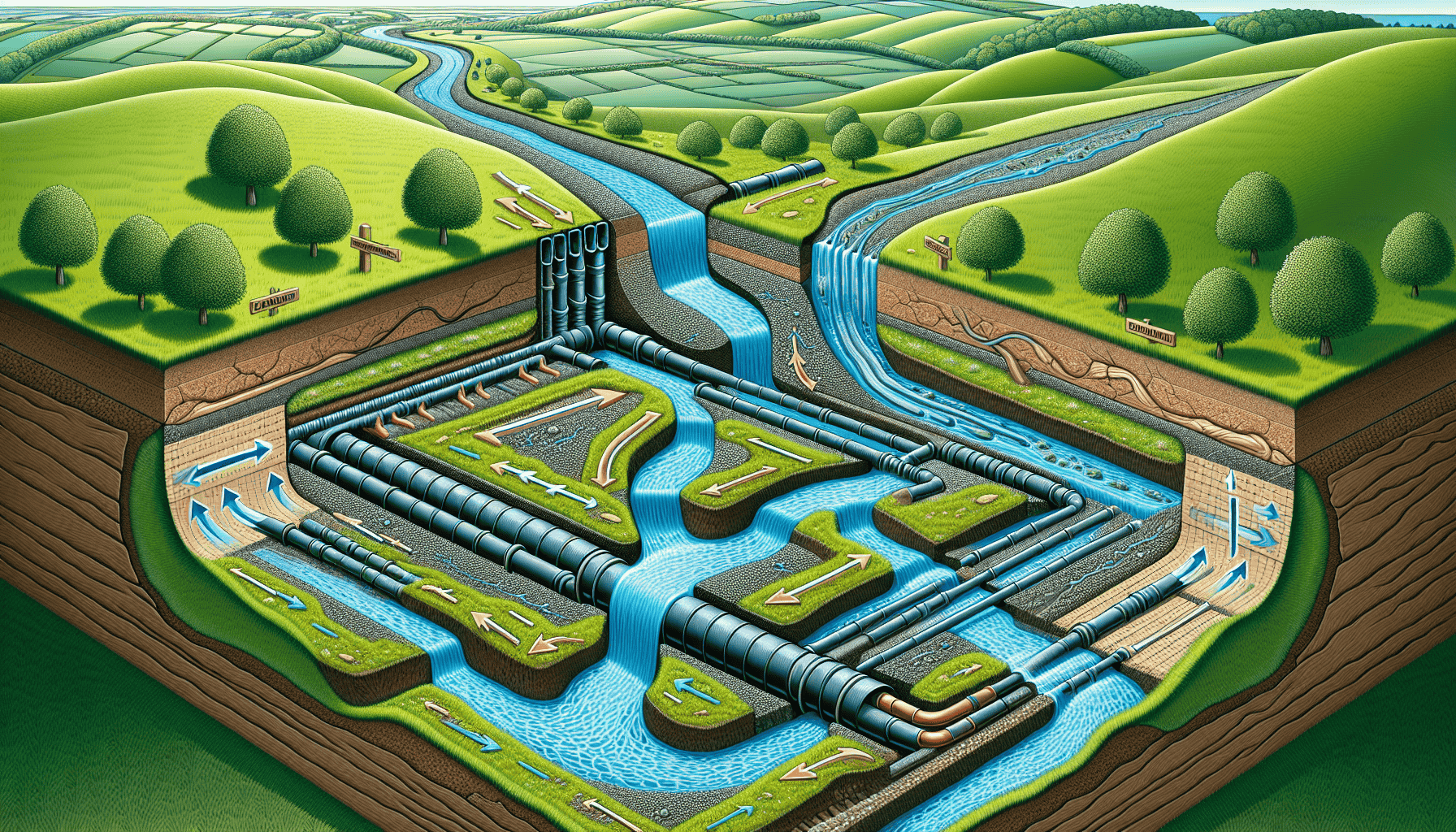
Creating a functional drainage system requires a holistic strategy, factoring in elements like the conditions of the soil, landscape contours, and pinpointing areas that need improved drainage. This is done to enhance the quality of the soil for optimal pasture growth and crop yield.
Consultation with local officials and seasoned professionals can provide critical guidance while also ensuring adherence to pertinent legal standards.
Surface Drainage Solutions
Solutions for surface drainage, such as surface ditches and diversion channels, are effective in controlling water on the ground surface. They channel water away from susceptible grassland zones to avoid pooling and avert oversaturation of soil.
To endure the wear from heavy machinery traffic, these diversion structures can be crafted out of robust materials such as metal or concrete.
Subsurface Drainage Systems
Tile drainage, a form of subsurface drainage system, effectively mitigates surplus moisture and improves the air supply within the soil of agricultural lands. By doing so, it fosters more consistent behavior in the soil and enhances overall drainage quality.
When constructed with proper planning and appropriate outlets, these tile-based drainage systems excel at regulating excess water levels to optimize the moisture condition of soils.
Controlled Drainage Techniques
Techniques for controlled drainage facilitate the regulation of water levels, optimizing soil vitality under diverse climatic scenarios. Maintaining appropriate moisture content in the soil is essential for promoting plant health through these methods.
In sustainable pasture management, implementing controlled drainage plays a vital role by ensuring effective adaptation to fluctuating weather patterns.
Choosing the Right Drainage Tiles
Selecting appropriate drainage tiles is essential for the efficacy of a water management system. It’s important to take into account elements such as soil compatibility, prevailing weather conditions, and the unique requirements for managing water in your pasture.
Investing in premium drainage tiles can diminish problems with excess moisture and enhance the productivity of pastures, which results in cost savings over an extended period.
Types of Drainage Tiles
A range of drain tile options, including plastic tiles and pipes with perforations, are adept at removing surplus water from grazing land.
Compared to conventional approaches, pattern tile drainage offers improved consistency in the spacing of drains. This makes it a favored option among numerous agriculturalists who implement a tile drainage system.
Installation Best Practices
Proper installation of tile drainage is critical to ensure they function as intended. The typical machinery used for installing these tiles includes trenchers, mole ploughs, and backhoes. Employing area contractors can guarantee the quality of the installation process. Maintaining detailed records and diagrams is crucial for any subsequent maintenance or troubleshooting needs related to the drainage system.
Maintenance and Inspection of Drainage Systems
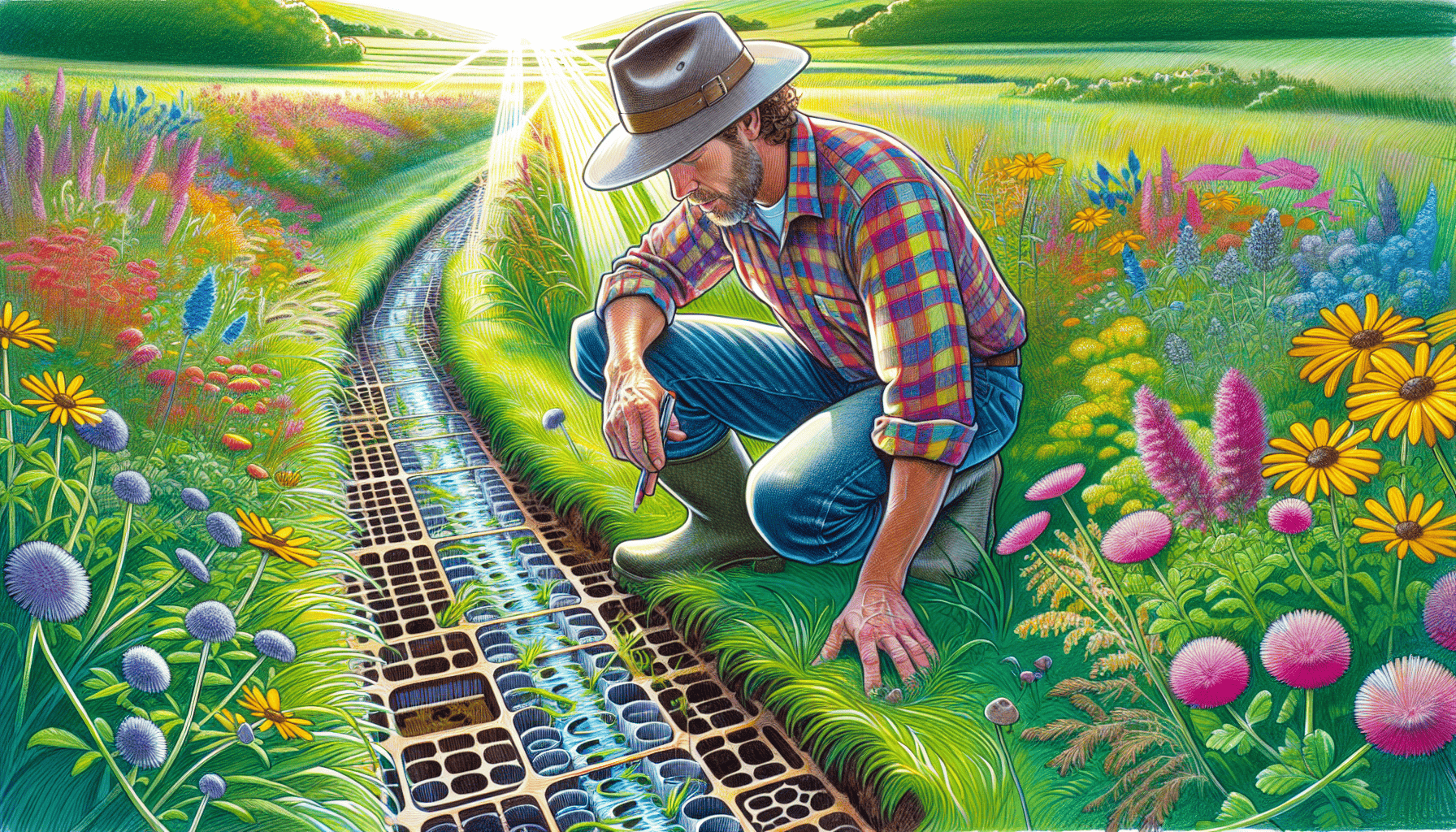
To safeguard the durability and performance of drainage systems, it’s crucial to perform consistent maintenance and inspections. Conducting regular assessments post-significant weather events along with yearly examinations can pinpoint minor problems, preventing them from escalating into expensive repairs.
Routine Inspections
To ensure the efficiency of a tile drainage system, it’s essential to frequently check for problems such as clogs or tile blowouts. Signs that indicate an obstruction in the system often involve water lingering on the surface several days following intense rainfall. Tree roots may interfere with lines within the tile drainage, impeding the flow of water. Thus, consistent surveillance is imperative.
Seasonal Maintenance Tips
To avert issues with drainage, routine maintenance must be coordinated with climatic trends. Inspections during winter should look for damage to drainage elements that could result from freezing conditions. By strategically placing surface drains, erosion can be prevented and the concentration of water flows can be improved.
Enhancing Soil Health and Structure
Improving the structure and health of soil contributes to better drainage and increases the productivity of pastures. Practices such as adding organic matter and aerating the soil can markedly enhance its condition.
Soil Aeration Techniques
Enhancing water infiltration and providing roots with increased oxygen availability, soil aeration is an effective way to promote healthier plant development. By aerating compacted soils, root growth is also improved alongside the betterment of water penetration.
Organic Matter Addition
Incorporating organic material into the soil improves its texture and increases its ability to hold water, markedly advancing the health of the soil and aiding in more effective water management.
Managing Excess Surface Water
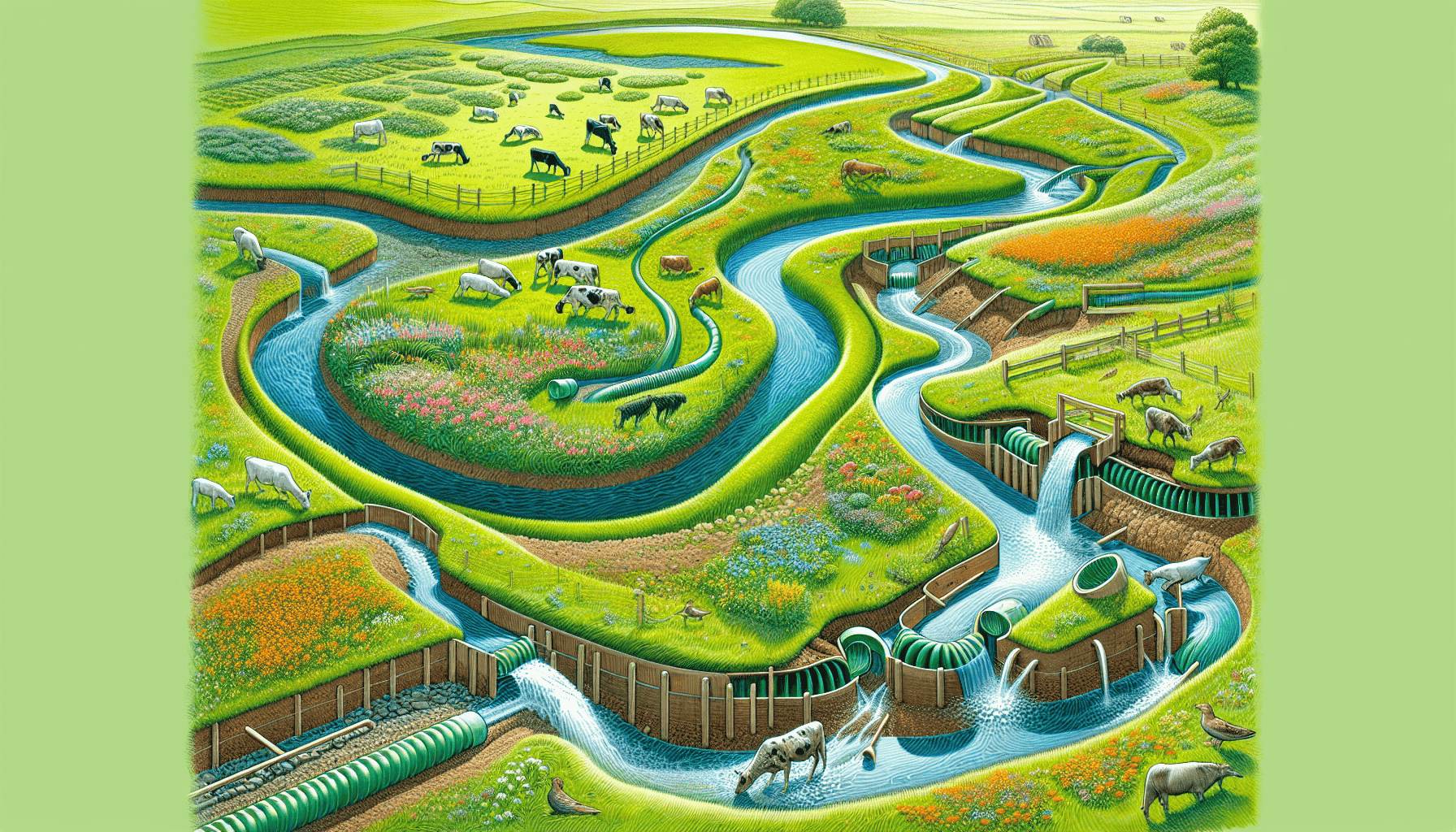
Employing strategies such as the formation of diversion channels and the establishment of buffer strips is vital for effectively handling excess surface water, thus avoiding waterlogging and ensuring that pastures remain in good condition.
Creating Diversion Channels
Constructing diversion channels serves to reroute water from key grazing areas, averting the risk of waterlogging and contributing to more robust conditions for pasture. By doing so, these channels mitigate adverse effects and bolster overall agricultural productivity.
Planting Buffer Strips
Buffer strips, also known as vegetative buffers, play a critical role in pastures by absorbing excess water and controlling runoff. This not only prevents soil from becoming waterlogged, but also promotes better soil health.
Long-Term Investment in Pasture Drainage

Putting resources into efficient drainage systems yields long-lasting rewards, such as increased productivity and diminished environmental hazards. Regular maintenance of these drainage networks ensures a steady food supply by bolstering crop yields.
Cost-Benefit Analysis
An economic assessment of investments in drainage systems underscores the possible gains in crop yields and reductions in expenses. Efficiently established systems have been shown to augment yields by 15% to 25%, validating their investment value.
Funding and Support Options
Improving drainage systems for pastures, particularly tile drainage, hinges on the availability of support and funding options. To install tile drainage, authorization from the USDA is necessary, while guidance regarding accessible financial opportunities can be sought at the local County Farm Service Agency (FSA) office.
Summary
The synopsis will highlight the crucial aspects covered, underlining how vital efficient drainage systems are to enhance and sustain productivity in pastures. It is intended to motivate readers to put into action the recommended best practices for drainage detailed within the guide.
Frequently Asked Questions
What are the common signs of poor drainage in pastures?
Evident indications of inadequate drainage in pastures are noticeable waterlogging, extended periods of wetness, and a water table that is near the surface of the soil.
It’s critical to tackle these problems swiftly to preserve the health of the pasture.
How does soil type affect drainage effectiveness?
The efficacy of tile drainage systems is deeply connected to the characteristics inherent to specific types of soil. Soils with a coarser texture Facilitate improved drainage as opposed to soils composed of finer particles.
The performance of tile drainage in managing water flow is greatly influenced by the type of soil present. With coarse-grained soils, they usually enable more effective drainage solutions than their finer-grained counterparts.
What are the benefits of subsurface drainage systems?
Drainage systems located beneath the surface effectively remove surplus water, considerably boosting soil ventilation. This improvement leads to healthier plant development and overall better condition of the soil.
Such enhancements lead to agricultural practices that are more sustainable due to the contributions made by these subsurface drainage benefits.
How often should drainage systems be inspected?
Drainage systems should be inspected regularly, especially after major storms, to identify and promptly resolve issues such as clogs and tile blowouts.
Regular assessments are essential for optimal drainage performance.
What funding options are available for improving pasture drainage systems?
Local County Farm Service Agency (FSA) offices provide financial assistance and support for the installation of tile drainage, as offered by the USDA.
To obtain precise information on these funding opportunities, it is recommended to contact your local FSA office.

